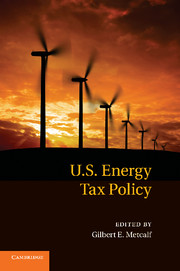Book contents
- Frontmatter
- Contents
- Conference Participants
- 1 Introduction
- 2 Distributional Impacts of Carbon Pricing Policies in the Electricity Sector
- 3 Distributional Impacts of a U.S. Greenhouse Gas Policy
- 4 Instrument Choice Is Instrument Design
- 5 Taxes, Permits, and Climate Change
- 6 Border Adjustments for Carbon Taxes and the Cost of Emissions Permits
- 7 Taxes and Caps as Climate Policy Instruments with Domestic and Imported Fuels
- 8 How Much Should Highway Fuels Be Taxed?
- 9 State Tax Policy and Oil Production
- 10 The Social Costs and Benefits of U.S. Biofuel Policies with Preexisting Distortions
- Index
- References
3 - Distributional Impacts of a U.S. Greenhouse Gas Policy
A General Equilibrium Analysis of Carbon Pricing
Published online by Cambridge University Press: 01 June 2011
- Frontmatter
- Contents
- Conference Participants
- 1 Introduction
- 2 Distributional Impacts of Carbon Pricing Policies in the Electricity Sector
- 3 Distributional Impacts of a U.S. Greenhouse Gas Policy
- 4 Instrument Choice Is Instrument Design
- 5 Taxes, Permits, and Climate Change
- 6 Border Adjustments for Carbon Taxes and the Cost of Emissions Permits
- 7 Taxes and Caps as Climate Policy Instruments with Domestic and Imported Fuels
- 8 How Much Should Highway Fuels Be Taxed?
- 9 State Tax Policy and Oil Production
- 10 The Social Costs and Benefits of U.S. Biofuel Policies with Preexisting Distortions
- Index
- References
Summary
Introduction
The United States is moving closer to enacting comprehensive climate change policy. President Obama campaigned in 2008 in part on a platform of re-engaging in the international negotiations on climate policy and supported a U.S. cap-and-trade policy with 100 percent auctioning of permits. Congress moved rapidly in 2009, with the House of Representatives voting favorably on the American Clean Energy and Security Act of 2009 (H.R. 2454) in late June of that year. What will happen in the Senate is still unresolved as this is written.
H.R. 2454 establishes a cap-and-trade system to reduce greenhouse gas emissions 17 percent below 2005 levels by 2020 and 83 percent by 2050. Among other provisions, it contains new energy efficiency standards for various appliances and a renewable electricity standard that requires retail suppliers to meet 20 percent of their electricity demand through renewable sources and energy efficiency by 2020 (see Holt and Whitney [2009] for a detailed description of the bill).
Cap-and-trade legislation acts like a tax in raising the price of carbon-based fuels and other covered inputs that release greenhouse gases. The monies involved in a cap-and-trade program are significant. The Congressional Budget Office estimated in June 2009 that H.R. 2454 would increase federal revenues by nearly $850 billion between 2010 and 2019. Because the bulk of permits are freely allocated in the early years of the program, spending would also increase over that period by roughly $820 billion.
- Type
- Chapter
- Information
- US Energy Tax Policy , pp. 52 - 107Publisher: Cambridge University PressPrint publication year: 2010
References
- 14
- Cited by



